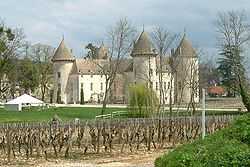Jules Guyot

Dr. Jules Guyot (1807 - March 31, 1872) was a French physician and agronomist who was born in the commune of Gyé-sur-Seine in the department of Aube. Guyot studied medicine in Paris, and had an avid interest in mechanics, physics and telegraphy, but he is best known for his work in viticulture.
Biography
As a student, Guyot participated in the 1830 July Revolution, and during the unrest in 1831 was jailed in the Sainte-Pélagie prison. He has a cultivated variety of pear called the Docteur Jules Guyot named after him, and the L'institut universitaire de la Vigne et du Vin (aka Institute Jules Guyot) at the University of Burgundy in Dijon is named in his honor. This institute offers degrees in the study of oenology.
Career
Guyot is remembered for making improvements in the cultivation and preparation of grapevines for the production of quality wines. He introduced the Guyot system of "cane-pruning" of vines for trellises. The Guyot system is extensively used throughout vineyards in Europe. The terms "single Guyot" and "double Guyot" are used for different techniques in the training of vines. His best known written works are: Culture de la vigne et vinification, and Étude des vignobles de France, pour servir à l'enseignement mutuel de la viticulture et de la vinification françaises. The latter work concerned Guyot's six-year research (1861-67) of vineyards in 71 departments throughout France.
References
- This article is based on a translation of an article from the German and French Wikipedia.
External links
|